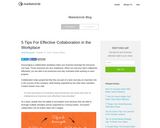
Article describes how to effectively collaborate with other employees in the workplace
- Subject:
- Career and Technical Education
- Material Type:
- Reading
- Reference Material
- Author:
- Kristen Holden
- Date Added:
- 05/22/2018

Article describes how to effectively collaborate with other employees in the workplace
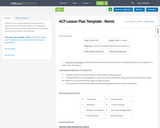
Students will use engineering skills to develop and use models as well as collaboratively plan an investigation to make sense of buoyancy.
Remix this template to upload your ACP lesson and unit plans into WISELearn.
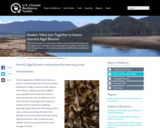
Tribal communities in southeastern Alaska are partnering with federal and state agencies to investigate increasing harmful algal bloomsevents that pose human health risks to subsistence harvesters.
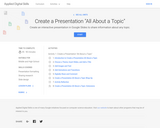
This 45-90 minute Google Applied Digital Skills lesson includes videos, lesson plans, and rubric. It is appropriate for middle school and high school students. It teaches transitions and animation along with collaboration.

Welcome to one of 12 Business, Marketing and Information Technology Quality Modules! The purpose of these modules is to illustrate quality examples of each of the 2018 ACTE Quality CTE Framework elements. Regardless if you are in a pre-service education program or an experienced educator, these modules will benefit your future and business & marketing program.The Standards-Aligned and Integrated Curriculum Module addresses the development, implementation and revision of the program of study curriculum, including the relevant knowledge and skills taught in the program and the standards on which they are based.
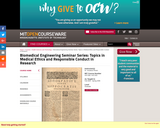
Seminars exploring current research and topical issues in the biomedical sciences, addressed at the general theme of innovation. Seminars are organized in blocks with related content, and are presented by prominent outside speakers as well as by HST faculty members and graduate students. Each seminar block includes several semi-weekly presentations, in addition to wide-ranging discussions among speakers, faculty, and students. Discussions involve issues such as relations between presented research areas, requirements for further advances in the "state of the art", the role of enabling technologies, the responsible practice of biomedical research, and career paths in the biomedical sciences.
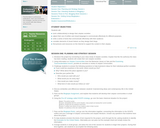
After studying utopian literature, students design their own utopian society, publishing the explanation of their ideal world on a blog. As they blog about their utopia, students establish the habits, practices, and organizing social structures that citizens will follow in their utopian societies. They begin by brainstorming ideas about what a perfect society would be like and then, in groups, begin to plan their project. Next, they become familiar with the blogging process, including legal guidelines and the specific site they will be using. Over several class sessions, students work on their blogs comparing their work to a rubric. Finally, after students visit one another's blogs and provide constructive and supportive feedback, they reflect on their own work. The lesson plan includes alternative handouts for classrooms where computer or blog access is limited. In this alternative, students complete the same basic activities, but publish their work using a Flip Book.
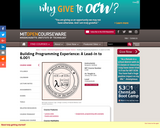
This course will serve as a two-week aggressively gentle introduction to programming for those students who lack background in the field. Specifically targeted at students with little or no programming experience, the course seeks to reach students who intend to take 6.001 in the Spring Term and feel they would struggle because they lack the necessary background. The main focus of the subject will be acquiring programming experience: instruction in programming fundamentals coupled with lots of practice problems. Lots of programming required, but lots of support provided.
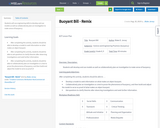
Students will use engineering skills to develop and use models as well as collaboratively plan an investigation to make sense of buoyancy.
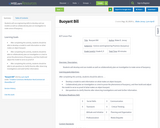
Students will use engineering skills to develop and use models as well as collaboratively plan an investigation to make sense of buoyancy.
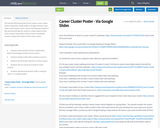
This activity will demonstrate how to create a career cluster poster using either Google Slides or Google Drawing.
Career Poster must include:
Career Cluster Title
Pathways
Hobbies
A QR code that will take the viewer to a video based on their career cluster
A description of their cluster
A handmade mascot or object that relates to their career cluster
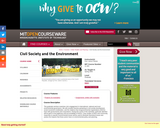
This graduate seminar examines the roles that civil society actors play in international, national, and local environmental governance. We will consider theories pertaining to civil society development, social movement mobilization, and relations between state and non-state actors. During the course of the semester, particular attention will be given to the legitimacy and accountability of nongovernmental organizations (NGOs). Case studies of civil society response to specific environmental issues will be used to illustrate theoretical issues and assess the impacts that these actors have on environmental policy and planning.
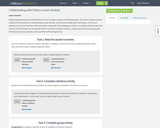
Collaborating with others is essential for success in today’s project-oriented workplace. This lesson module teaches students the importance of collaborating, its key benefits, and effective collaboration techniques. Teach your students how to use their best skills and talents, along with the knowledge of others, to complete difficult tasks and achieve more than they can accomplish alone. The lesson module contains a student narrative, discussion guide, individual and group activities, and a posttest with descriptive key.

Plan and manage collaboration activities that integrate online tools, which are increasingly an integral part of our digital, global world. This resource includes a Common Cartridge backup (.imscc file) that you can restore to your own LMS instance. Note: If you are using Canvas, use the .MBZ (Moodle) version of the course. Download of Moodle or Common Cartridge will begin once you click on this resource.

Plan and manage collaboration activities that integrate online tools, which are increasingly an integral part of our digital, global world. This resource includes a Moodle 3.1 course backup (.MBZ file) that you can restore to your own Moodle instance. Note: If you are using Canvas, use the .MBZ (Moodle) version of the course. Download of Moodle or Common Cartridge will begin once you click on this resource.

Plan and manage collaboration activities that integrate online tools, which are increasingly an integral part of our digital, global world. This resource includes a Common Cartridge backup (.imscc file) that you can restore to your own LMS instance. Note: If you are using Canvas, use the .MBZ (Moodle) version of the course. Download of Moodle or Common Cartridge will begin once you click on this resource.

Plan and manage collaboration activities that integrate online tools, which are increasingly an integral part of our digital, global world. This resource includes a Common Cartridge backup (.imscc file) that you can restore to your own LMS instance. Note: If you are using Canvas, use the .MBZ (Moodle) version of the course. Download of Moodle or Common Cartridge will begin once you click on this resource.

Plan and manage collaboration activities that integrate online tools, which are increasingly an integral part of our digital, global world. This resource includes a Moodle 3.1 course backup (.MBZ file) that you can restore to your own Moodle instance. Note: If you are using Canvas, use the .MBZ (Moodle) version of the course. Download of Moodle or Common Cartridge will begin once you click on this resource.

Plan and manage collaboration activities that integrate online tools, which are increasingly an integral part of our digital, global world. This resource includes a Common Cartridge backup (.imscc file) that you can restore to your own LMS instance. Note: If you are using Canvas, use the .MBZ (Moodle) version of the course. Download of Moodle or Common Cartridge will begin once you click on this resource.
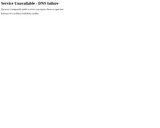
Plan and manage collaboration activities that integrate online tools, which are increasingly an integral part of our digital, global world. This resource includes a Moodle 3.1 course backup (.MBZ file) that you can restore to your own Moodle instance. Note: If you are using Canvas, use the .MBZ (Moodle) version of the course. Download of Moodle or Common Cartridge will begin once you click on this resource.